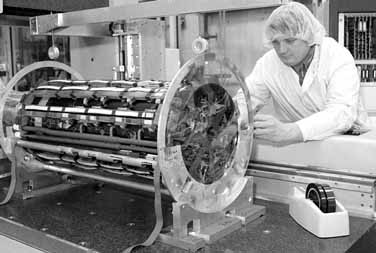 |
|
Moving In for a Closer Look by Mike Perricone One of the smallest sub-assemblies in the revamped 5,000-ton DZero detector crams 800,000 electronic channels into a volume you can wrap your arms around, and it will bring physicists an up-close and personal look at particle collisions unlike anything they've experienced in this detector's history.
"The high resolution offered by silicon will allow us to identify b [bottom] quarks by their decay lifetimes, and the b quark is a strong sign for new physics," said DZero cospokesperson John Womersley. "We will be able to tell whether a particle originated at the collision point, or from a secondary decay. We will now have extremely precise particle tracking, with precise measurements of every charged track." Without silicon, DZero nevertheless shared in the discovery of the top quark with silicon-equipped CDF in 1995; with silicon added, only 1.8 mm away from the beam pipe, the anticipation for Run II at DZero is tangible. "Silicon has 10 to 20 times the resolution of other detectors," emphasized Ron Lipton, one of two sub-project managers for building the central detector. "We'll be able to distinguish particles with relatively short lifetimesˇespecially, telling b and c [charm] quarks from their less-interesting friends. That gives us a tremendous advantage in looking for new physics. Identifying these heavy quarks is crucial to the kind of forefront physics we want to do." The morning of December 18 was typical of this early and severe winter sweeping across the Illinois plains: gray, windy and frigid, with snow threatening any minute. Lipton, his co-manager Marcel Demarteau and DZero associate upgrade project manager Jon Kotcher supervised moving the 35-pound half-cylinder from SiDet, Fermilab's Silicon Detector Facility, onto a special rolling cart dubbed "the lunar rover" or "baby carriage" and then to the back of a truck for the careful two-mile ride to the detector's assembly building, where it joined the waiting first half-cylinder. "The cold was more of a problem for the people riding along in the back of an unheated truck," Kotcher said. "When a device is designed to operate at around -10 degrees Celsius, a cold winter's day isn't much of a problem."
"All the components have to work in concert," said Demarteau. "Reading out 800,000 channels isn't peanuts. Essentially, you have to check out every bit of data that comes out of the detector." During the "10 percent test" at SiDet, it took more than a year to read out 80,000 channels without error during construction. Commissioning is a 100 percent test. "We'll have to verify that all readout systems work well and reliably before they're connect to each ladder or wedge," said Kotcher. "We'll connect one at a time, read them out, check them electronically to make sure the channel orders are right, and the noise looks right. It's a major effort to go through each one, to get ready for beam."
"It's been an intense effort by the collaboration and by the lab as well," said Kotcher. "I think you could rightly call this a technical tour de force."
For more information on the DZero detector and silicon upgrades, see:
|
| last modified 1/19/2001 email Fermilab |
FRLsDFx9eyfrPXgV
 With the joining of the two half-cylinders of the Central Silicon Detector around the beam pipe at the very heart of DZero, the silicon era came to the huge experimental apparatus. And when Collider Run II of the Tevatron makes its debut in March, this new silicon region will give DZero a state-of-the-art chance at once more making history in the search for the Higgs and other particle discoveries.
With the joining of the two half-cylinders of the Central Silicon Detector around the beam pipe at the very heart of DZero, the silicon era came to the huge experimental apparatus. And when Collider Run II of the Tevatron makes its debut in March, this new silicon region will give DZero a state-of-the-art chance at once more making history in the search for the Higgs and other particle discoveries.
 No problem, that is, unless the unit were to warm up in a moist atmosphere, with moisture condensing inside it. "Purging" the device with dry air averted that threat. But shifting the detector into position by crane only marked the end of the journey, not the end of the process. The entire cylinder plus cables weighs about 70 pounds. Most of the cylinder's weight comes from the cables attached to it; connecting those cables and testing the circuits is in some ways as big a project as building and installing the detector.
No problem, that is, unless the unit were to warm up in a moist atmosphere, with moisture condensing inside it. "Purging" the device with dry air averted that threat. But shifting the detector into position by crane only marked the end of the journey, not the end of the process. The entire cylinder plus cables weighs about 70 pounds. Most of the cylinder's weight comes from the cables attached to it; connecting those cables and testing the circuits is in some ways as big a project as building and installing the detector.